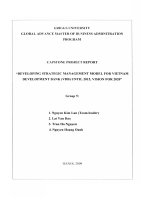Strategic management planning for domestic and global competition 14th ed pearce robinson chapter 5
Bạn đang xem bản rút gọn của tài liệu. Xem và tải ngay bản đầy đủ của tài liệu tại đây (197.11 KB, 29 trang )
Chapter 5
The Global
Environment
© 2015 by McGraw-Hill Education. This is proprietary material solely for authorized instructor use. Not authorized for sale or distribution in any manner. This document may not be copied, scanned, duplicated, forwarded, distributed, or
posted on a website, in whole or part.
Learning Objectives
1.
2.
3.
4.
5.
6.
The importance of a company’s decision to globalize
The four main strategic orientations of global firms
The complexity of the global environment and the control problems that
are faced by global firms
Major issues in global strategic planning, including the differences for
multinational and global firms
The market requirements and product characteristics in global
competition
The competitive strategies for firms in foreign markets
2
Globalization
•
Globalization refers to the strategy of pursuing opportunities anywhere in the
world that enable a firm to optimize its business functions in the countries in
which it operates.
3
Globalization (contd.)
•
•
Awareness of the strategic opportunities faced by global corporations and of
the threats posed to them is important to planners in almost every domestic
U.S. industry
Understanding the nuances of competing in global markets is rapidly
becoming a required competence of strategic managers
4
Development of a Global Corporation
Four Levels
1.
2.
Level 1 – export/import activity has minimal effect on the existing management
orientation or on existing product lines
Level 2 – foreign licensing and technology transfer requires little change in management or
operation
5
Development of a Global Corporation (contd.)
3.
4.
Level 3 – direct investment in overseas operations –is characterized by large capital
outlays and the development of global management skills
Level 4 – substantial increase in foreign investment – the firm begins to emerge as a global
enterprise with foreign assets comprising a significant portion of total assets
6
Why Firms Globalize?
• U.S. firms can reap benefits from industries and technologies developed abroad.
• Direct penetration of foreign markets can drain vital cash flows from a foreign competitor’s
domestic operations.
• The resulting lost opportunities, reduced income, and limited production can impair the
competitor’s ability to invade U.S. markets.
Question: Should firms be proactive or reactive?
7
Reasons for Going Global
•
•
•
•
•
•
•
•
•
•
PROACTIVE
Additional resources
Lowered costs
Incentives
New, expanded markets
Exploitation of firm-specific advantages
Taxes
Economies of scale
Synergy
Power and prestige
Protect home market
8
Reasons for Going Global (contd.)
•
•
•
•
•
REACTIVE
Trade barriers
International customers
International competition
Regulations
Chance
9
4 Strategic Orientations of Global Firms
•
Ethnocentric orientation
•
When the values and priorities of the parent organization guide the strategic decision
making of all its international operations
10
4 Strategic Orientations of Global Firms (contd.)
•
Polycentric orientation
•
When the culture of the country in which the strategy is to be implemented is allowed
to dominate a company’s international decision making process
11
4 Strategic Orientations of Global Firms (contd.)
•
Regiocentric orientation
•
When a parent company blends its own predisposition with those of its international
units to develop region-sensitive strategies.
12
4 Strategic Orientations of Global Firms (contd.)
•
Geocentric orientation
•
When an international firm adopts a systems approach to strategic decision making
that emphasizes global integration.
13
At the Start of Globalization
•
•
External and internal assessments are conducted before a firm enters global markets
External assessment involves careful examination of critical features of the global
environment
•
Internal assessment involves identification of the basic strengths of a firm’s operations
14
Complexity of the Global Environment
•
Five factors affecting the increasing complexity of global strategic planning:
Multiple political, economic, legal, social, and cultural environments as well as
various rates of change
Interactions between the national and foreign environments are complex
Geographic separation, cultural and national differences, and variations in
business practices all tend to make communication and control efforts difficult
15
Complexity of the Global Environment (contd.)
Globals face extreme competition
Globals are restricted in their selection of competitive strategies by various regional
blocs and economic integrations
16
Control Problems of the Global Firm
•
•
•
•
Financial policies typically are designed to further the goals of the parent
company and pay minimal attention to the goals of the host countries
Different financial environments make normal standards of company
behavior more problematic
Important differences in measurement and control systems often exist
These problems can be reduced through more attention to strategic
planning
17
Global Strategic Planning:
Stakeholder Activism
•
Demands placed on a global firm by the stakeholders in the environments in
which it operates, principally by foreign governments.
18
Global Strategic Planning
•
•
Increasingly complex decisions
Multidomestic vs. Global industries
–
–
–
A multidomestic industry is one in which competition is essentially segmented from country to country
In a multidomestic industry, a global corporation’s subsidiaries should be managed as distinct entities
A global industry is one in which competition crosses national borders
19
Multidomestic Industry
•
Factors that increase the degree to which an industry is multidomestic include:
The need for customized products to meet the tastes or preferences of local customers
Fragmentation of the industry, with many competitors in each national market
A lack of economies of scale in the functional activities of firms in the industry
Distribution channels unique to each country
A low technological dependence of subsidiaries on R&D provided by the global firm
20
Global Strategic Planning (contd.)
Reasons why strategic planning must be global:
• The increased scope of the global management task
• The increased globalization of firms
• The information explosion
• The increase in global competition
• The rapid development of technology
• Strategic management planning breeds managerial confidence
21
Global Industry
•
Factors that make for the creation of a global industry:
Economies of scale in the functional activities of firms in the industry
A high level of R&D expenditures on products that require more than one market to recover
development costs
The presence in the industry of predominantly global firms that expect consistency of
products and services across markets
The presence of homogeneous product needs across markets, which reduces the
requirement of customizing the product for each market
The presence of a small group of global competitors
A low level of trade regulation and of regulation regarding foreign direction investment
–
–
–
–
–
–
22
Competitive Strategies for Firms in Foreign Markets
•
Strategies for firms that are attempting to move toward globalization can be categorized by the
degree of complexity of each foreign market being considered and by the diversity in a
company’s product line
23
Competitive Strategies for Firms in Foreign Markets (contd.)
•
Complexity refers to the number of critical success factors that are required to
prosper in a given competitive arena
When a firm must consider many such factors, the requirements of success increase in complexity
24
Competitive Strategies for Firms in Foreign Markets (contd.)
•
Diversity, the second variable, refers to the breadth of a firm’s business lines
When a company offers many product lines, diversity is high
25









